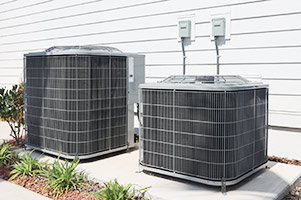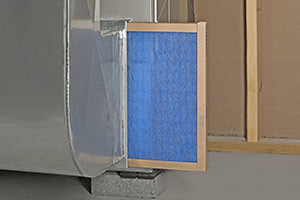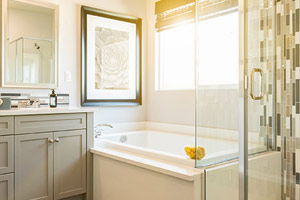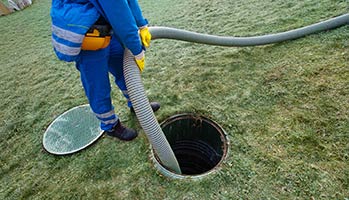Home Maintenance Topics
2-10 Maintenance Guide / Home Maintenance Topics / Systems Maintenance
Systems Maintenance
Air Conditioner Maintenance

- Replace air filter regularly based on manufacturer’s recommendation.
- Turn on system only when outside air temperature is greater than 60 degrees Fahrenheit.
- Set thermostat to desired temperature or to a temperature slightly higher than normal if away from home during the day. This will allow for quicker cooling to your desired temperature at night rather than trying to cool a hot house.
- If air conditioner does not operate, check thermostat is set to “COOL” setting. If that doesn’t help, check the circuit breakers.
- There are two: one that controls the compressor and one that controls the fan. Verify that both are in the “ON” position.
- If either is tripped, switch it to the “OFF” position then to the “ON” position.
- If that doesn’t work, call a qualified HVAC contractor for assistance as necessary.
- If the system is operating properly, ensure that the condensation drain tube is draining water and is unobstructed. This is usually a clear plastic tube located next to the heat pump which drains into a floor drain or to the outside.
- Verify that the outside compressor unit operates free and clear of any debris.
- Remove any protective cover left on the unit over the winter.
- Consider installing ceiling fans where desirable. They help with air circulation and enable the system to operate more efficiently.
- Reduce sunlight entering your home during the hottest parts of the day.
- Make sure all cooling and return air vents are clean, clear, and unobstructed.
- Set air vent vanes upward on lower floors and slightly downward on upper floors.
- Air blowing from the vents should be noticeably cool. If not, there may be a refrigerant leak somewhere. Consult with a qualified HVAC contractor as necessary.
Furnace Maintenance

- Replace air filter regularly based on manufacturer’s recommendation.
- If you ever smell natural gas, leave your home immediately. Call your natural gas provider after you’ve left your home.
- Turn on system only when outside air temperature is below 65 degrees Fahrenheit.
- Set thermostat at desired temperature. If the system does not operate, check to see that thermostat is set to “HEAT” setting. Also check that fan panel on furnace unit is secure.
- There is a switch behind the panel that will keep the furnace from operating if the panel is loose.
- If that doesn’t work, check the circuit breakers. Verify that breakers are in the “ON” position. If any breakers relating to the fan or compressor are tripped, switch them to the “OFF” position then to the “ON” position.
- Otherwise, consult with a qualified HVAC contractor for assistance as necessary.
- If the system is operating properly, confirm that noticeably warm air is blowing out of the air vents. A mild odor is common the first time you turn on the heat and should dissipate shortly.
- Check that any auxiliary heaters are operational (heat pump).
- Occasionally, heat pumps will activate a defrost cycle which will melt ice buildup on the internal coils of the outside unit. When this occurs, steam will be seen rising from the unit. This is normal and not cause for concern, but use your best judgment if things don’t seem right.
- Make sure the fresh air duct near a natural gas unit is open and unobstructed.
- Consider installing ceiling fans where desirable. They help with air circulation and enable the system to operate more efficiently.
- Allow sunlight to enter your home during the warmest parts of the day.
- Make sure all heating and return air vents are clean, clear, and unobstructed.
- Set air vent vanes downward on lower floors and slightly upward on upper floors.
Electrical Maintenance

- Look for rust, water stains, soot stains, or melted wires at the service panel.
- Check the circuit breakers and see that they are properly labeled.
- Do a quick check to verify that the labeled circuit is actually the correct circuit by switching off the breaker and trying some of the devices connected to that circuit. If it’s not correctly labeled, re-label it and investigate the remaining circuits.
- Circuit breakers have three positions: “ON”, “OFF,” and “tripped.” Circuit breakers will trip, or shut down, if they exceed the maximum allowed current, typically 15 to 20 Amps.
- If any breakers are tripped, switch them to “OFF” then back to “ON.” If the breaker trips again, unplug all devices on that circuit.
- If this corrects the problem, then there are too many devices plugged in to this circuit or one of the devices or cords is faulty, unsafe, and leaking electrical current.
- If the breaker continues to trip, consult with a qualified electrician as necessary.
- Check all GFI outlets and breakers. Push the “TEST” button at least once a month to trip the circuit.
- If the “RESET” button doesn’t pop outward during this test, consult with a qualified electrician, as necessary, to replace the GFI switch.
- If it does pop out, push it back in and repeat next month.
- Do not plug refrigerators or freezers into a GFI circuit. These appliances experience sudden large power draws, which can trip the GFI switch and spoil the food!
- In general, keep tree limbs away from any overhead power lines.
- Always call your electrical utility service to locate underground power lines before digging any trenches or holes.
- If an electrical outlet doesn’t work, see if it’s controlled by a switch, GFI switch, or if the breaker has tripped, before calling an electrician.
- Don’t use light bulbs with a higher wattage than the fixture allows.
- Avoid changing exterior light bulbs in the rain.
- Never overload extension cords or use too many when bringing power to a remote device or fixture. Check the label for restrictions.
- Plug sensitive electronic devices such as televisions, computers, and printers into appropriate surge protector strips. Unplug them during lightning storms. If there are small children in the home, install outlet protector guards to keep out little fingers and paper clips.
Plumbing Maintenance

- While monitoring, simultaneously turn on the water at all sinks, bathtubs, and showers; operate dishwasher and washing machine; and flush all toilets. Check on all drains first to make sure nothing overflows. Then, look for any leaks in the water and sewer pipes.
- Look in cabinets, closets, on the floor, under lower-level ceilings, and in the basement or crawl spaces (if applicable). Water pipes will be copper (metal) or gray plastic. Sewer pipes will be white or black plastic.
- If any water line leaks are found, locate the shut-off valve nearest to the leak and turn the valve to the right (clockwise) until tight.
- If any sewer line leaks are found, try to trace the piping back to the area it serves and discontinue use of those fixtures until repairs are made.
- If freezing temperatures occur, make sure to disconnect the outside garden hoses to keep inner water pipes from freezing and bursting at the spigot. Allow an indoor faucet to drip to reduce the likelihood of pipes freezing. Read more about reducing frozen pipes.
- Only flush toilet paper down the toilet. Avoid flushing paper towels, feminine hygiene products, and wipes, even if they claim to be flushable.
- Use a plunger to attempt to address clogs.
- If toilet clogs and begins to overflow, turn off water supply at shutoff valve near the floor. Use a rubber plunger or a coil-spring auger to clear any clogs.
- If toilet runs constantly, try adjusting the float mechanism in the tank to shut off fill-water sooner.
- Consult with a qualified plumber as necessary.
Plumbing Fixtures Maintenance

Sinks
- Turn on the hot and cold water and observe for adequate water pressure and drainage.
- If water pressure is low, unscrew the piece (aerator) at the end of the spigot and inspect the filter screen. Wash out any trapped pieces of debris, then reinstall.
- If sink is slow to drain, you can try some drain cleaner to see if that helps. Use a funnel when pouring to avoid splashing acid on the basin surface. Drain cleaners should not be used if your home is on a septic system.
- Another alternative to clear a drain would be to disassemble the trap (“U”-shaped pipe) under the sink to try and clear any obstruction. Put a bucket under the trap first, as it usually contains a small amount of water. This also works well for fishing out small valuables that go down the drain.
- To clean sink surfaces, use a non-abrasive cleanser and warm water on a damp sponge.
Bathtubs & Sinks
- Turn on the cold and hot water and check for adequate water pressure and drainage.
- If you notice low water pressure in the shower, unscrew the shower head and flush it out, against the direction of normal flow, to clear any debris.
- A rubber plunger can usually unclog any drain obstructions. If that doesn’t work, you can try some drain cleaner to see if that helps, but again, use a funnel when pouring to avoid splashing acid on the tub or shower surface.
- Drain cleaners should not be used if your home is on a septic system.
- Clean surfaces with a non-abrasive cleanser and warm water on a damp sponge.
- Use brass cleaner on solid brass fixtures, not coated brass.
Toilets
- Clean often using a non-abrasive cleanser. Never mix cleaners, especially those containing bleach.
- Avoid scrubbing bowl too hard with a toilet brush. Bristle rod may scratch porcelain.
- Avoid using drop-in type cleaners.
- Condensation on the outside of the tank is not a leak – try purchasing a tank cover if desired.
Spas/Jetted Tubs
- See “Bathtubs & Sinks” above for cleaning suggestions.
- To avoid motor damage, never operate jets unless outlet ports are covered by at least three inches of water.
- If jets don’t work, check to see if GFI outlet switch is tripped in the tub equipment housing area.
Water Heater Maintenance

- Read the manufacturer’s operation manual, which explains how to periodically drain and refill the tank for optimal performance. Read more about draining your water heater.
- Check that temperature setting is set on letter “B”, “Normal,” or 140 degrees.
- For natural gas units, there is a pilot light and a main burner that heats the water. If the pilot light goes out, read the relighting instructions found on the side of the tank.
- Never turn on electricity to the unit or light the pilot if it has an empty tank.
- Always shut off the electric or gas supply before turning off the water supply.
- When away from your home for an extended time, turn the temperature down to its lowest setting.
- Never store combustible materials near a natural gas unit. Fumes are often heavier than air and can make their way to the pilot light.
- Vacuum often near the base of the unit to keep dust from interfering with the flame.
- Avoid using the top of the water heater as a storage shelf.
- Test the pressure relief valve at least once a year by briefly pulling up on the lever and confirming water discharge. Stay away from the end of discharge pipe when performing this test, due to scalding danger.
- Condensation at bottom of inner tank and above flame may not be a leak.
- . Water dripping from the bottom of the outer tank may be a leak.
- Consult with a qualified plumber as necessary.
Septic System Maintenance

- Know the location of your septic tank and drain field.
- Have your septic tank inspected annually by a licensed contractor or health department official. Inspection will reveal problems before they become serious and tell you when the tank needs to be pumped.
- Periodically check the drain field for a foul odor, excessive wetness, or overly lush grass growth, which may be warning signs of a failing system.
- Never drive or park over any part of the system.
- Do not plant anything but grass over or near drain field, as tree and shrub roots may cause clogging.
Water Well Maintenance

- Check water production. If well produces less water than usual, reduce water use or drill an additional well into a different aquifer.
- Clean water well system by shock chlorinating or hiring a drilling contractor.






